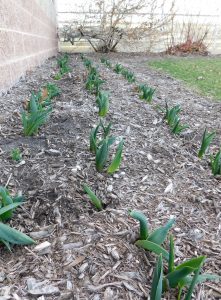Early spring brings either excitement or fear for area gardeners
Cathy Janek for Chronicle Media — March 15, 2017 Thanks to some very warm record-breaking February days throughout the Midwest–blooms, buds, and bright green leaves now are abundant.
Thanks to some very warm record-breaking February days throughout the Midwest–blooms, buds, and bright green leaves now are abundant.
These early sightings of buds on trees, blooms on ornamental bushes and the bright green leaves of tulips and daffodils emerging from the ground have garnered one of two reactions among gardeners:
Excitement or fear.
For those anxious gardeners worried about the health of these early blooming plants and trees, Richard Hentschel, a horticulture educator with the University of Illinois Extension said, “This spring, everything seems a bit more accelerated, but these plants have a level of protection within the plant that protect it from cold weather.”
Also he concedes, “There is nothing we can do to stop a 40 foot tree from blooming.”
Based on Hentschel’s observations, the dips into colder temperatures at night have not fazed his plants.
In addition, a few days of higher than normal temperatures may not adversely affect other plants either.
“It takes more consist warm weather for things to start to change in a plant,” he said. “Their root systems are down on the ground where it is quite cold,” he added.
But gardeners who took advantage of those early warm days and began their spring clean-up, raking leaves, may have removed the protection of those early buds, Hentschel said.
If temperatures do drop, he recommends placing mulch over those plants that are up and out of the ground or covering them with a blanket.
“This helps to capture the heat that is already in the ground and protect it from the colder air,” he said.
Nature’s early bloomers such as bulbs of daffodils typically, “peek their heads up pretty early,” he added.
“Then they will kind of sit there until the conditions are right. They use the tips of their foliage as an indicator and wait for better weather.”
Very early spring bulbs such as snow drops, he said, get their name because their blooms are white and also because they appear very early in spring—when snow is still on the ground.
Certain trees—like the silver maple typically flower the first week in March.
However, he said, this year, their buds started to swell 10 to 14 days earlier which is related to the signal they received from the warmer weather this spring.
Even with the wind and rain we have been experiencing, the silver maples are equipped to handle the changing weather, he added.
Hentschel also has come across ornamental plants with buds swelling that haven’t gone any farther.
“They started, but they are going to wait and see what happens,” he added.
Hentschel said some plants are always going to be susceptible to varying weather.
“Peach trees bloom early which can make them susceptible to a late frost.”
Typically, Hentschel said, plants on the south or west side of the home where the soil is warmer will begin to appear earlier, and thus could be more susceptible to a late frost.
Hentschel said this year, “the plant man’s crystal ball is especially cloudy.”
However, he suspects this year’s spring bloom show will be somewhat erratic.
The “strange weather events” along with heavy rains and winds all contribute to the viability of the plants.
Still, we are dealing with a “new normal” of spring in the Midwest, he added.
Oswego resident, Sandy Schilingo who is a master gardener, said several years ago most of the area was re-designated from Zone 5A to Zone 5B.
For gardeners, the zone classification is key in determining which plants will thrive based on location.
North America is divided into 11 plant hardiness zones determined by the USDA.
Living on a one acre property along the Fox River in Oswego, Schilingo said that the pussy willows on her property are already out as well as her snowdrops and reticulata irises.
Buds are appearing on her lilac bushes, she added. “It is going to be an early spring.”
“Most of the ones that come up at this time of year are pretty resilient,” she added.
Schilingo said she typically begins cleaning up her yard in mid-April when it is unlikely for a late in the season snowstorm.







